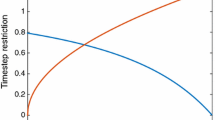Abstract
Strong stability preserving (SSP) high order time discretizations were developed for solution of semi-discrete method of lines approximations of hyperbolic partial differential equations. These high order time discretization methods preserve the strong stability properties-in any norm or seminorm—of the spatial discretization coupled with first order Euler time stepping. This paper describes the development of SSP methods and the recently developed theory which connects the timestep restriction on SSP methods with the theory of monotonicity and contractivity. Optimal explicit SSP Runge-Kutta methods for nonlinear problems and for linear problems as well as implicit Runge-Kutta methods and multi step methods will be collected.
Similar content being viewed by others
References
Carpenter, M., and Kennedy, C. (1994).Fourth-order 2N-storage Runge-Kutta schemes, NASA TM 109112, NASA Langley Research Center.
Chen, M.-H., Cockburn, B., and Reitich, F. High order RKDG methods for computational electromagnetics. Submitted.
Cockburn, B., and Shu, C.-W. (1989). TVB Runge-Kutta local projection discontinuous Galerkin finite element method for conservation laws II: general framework,Math. Comput. 52, 411–435.
Ferracina, L., and Spijker, M.N. (2002). Stepsize Restrictions for the total variation diminishing property in general Runge-Kutta methods.Num. Anal. Reports of Leiden University, Report MI 2002-21.
Ferracina, L., and Spijker, M.N. (2005). An extension and analysis of the Shu-Osher representation of Runge-Kutta method.Math. Comput. 74, 201–219.
Gottlieb, S., and Gottlieb, L.-J. (2003).Strong stability preserving properties of Runge-Kutta time discretization methods for linear constant coefficient operators, J. Sci. Compu. 18, 83–110.
Gottlieb, S., and Shu, C.-W. (1998). Total variation diminishing Runge-Kutta schemes,Math. Compu. 67, 73–85.
Gottlieb, S., Shu, C.-W., and Tadmor, E. (2001). Strong stability preserving high-order time discretization methods,SIAM Review 43, 89–112.
Gottlieb, D., and Tadmor, E. (1995). The CFL condition for spectral approximations to hyperbolic initial-boundary value problems,Math. Comput. 56, 565–588.
Gottlieb, S., and Ruuth, S.J. Strong stability preserving Runge-Kutta methods for fast downwind biased discretizations, to appear inJ. Sci. Comput.
Harten, A. (1983).High resolution schemes for hyperbolic conservation laws, J. Comput. Phys. 49, 357–393.
Higueras, I. (2004) On strong stability preserving methods.J. Sci Comput. 21, 193–223.
Higueras, I. (2003).Representations of Runge-Kutta Methods and Strong Stability Preserving Methods, Preprint Departmento de Matematica e Informatica, No. 2, seccion 1, Universidad Publica de Navarra.
Hundsdorfer, W., Ruuth, S.J., and Spiteri, R.J. (2003). Monotonicity-preserving linear multistep methods.SIAM J. Num. Anal. 41, 605–623.
Kennedy, C., Carpenter, M., and Lewis, R. (2000). Low storage explicit Runge-Kutta schemes for the compressible navier-stokes equations,Appl. Nume. Math. 35, 177–219.
Kraaijevanger, J.F.B.M. (1986).Absolute monotonicity of polynomials occurring in the numerical solution of initial value problems, Numerische Mathematik 48, 303–322.
Kraaijevanger, J.F.B.M. (1991).Contractivity of Runge-Kutta methods, BIT 31, 482–528.
Kurganov, A., and Tadmor, E.New high-resolution schemes for nonlinear conservation laws and related convection-diffusion equations, UCLA CAM Report No. 99-16.
Lenferink, H.W.J. (1991). Contractivity preserving implicit linear multi step methods,Math. Comput. 56, 177–199.
Levy, D. and Tadmor, E. (1998). From semi-discrete to fully discrete: stability of Runge-Kutta schemes by the energy method.SIAM Review,40, 40–73.
Liu, X-D., Osher, S., and Chan, T. (1994). Weighted essentially non-oscillatory schemesJ. Comput. Phys. 115 (1), 200.
Nessyahu, H., and Tadmor, E. (1990). Non-oscillatory central differencing for hyperbolic conservation laws,J. Comp. Phys. 87, 408–463.
Osher, S., and Chakravarthy, S. (1984). High resolution schemes and the entropy condition.SIAM J. Num. Anal. 21, 955–984.
Osher, S., and Tadmor, E. (1988). On the convergence of difference approximations to scalar conservation laws.Math. Comp. 50, 19–51.
Ruuth, S.J., and Spiteri, R.J. (2002). Two barriers on strong-stability-preserving time discretization methods.J. Sci. Comp. 17, 211–220.
Ruuth, S.J., and Spiteri, R.J. (2004). Downwinding in high-order strong-stability-preserving Runge-Kutta methods.SIAM J. Numer. Anal. 42, 974–996.
Ruuth, S. Global optimization of strong-stability preserving Runge-Kutta methods, to appear inMath. Comput.
Shu, C.-W. (1988). Total-variation-diminishing time discretizations.SIAM J. Sci. Stat. Comput. 9, 1073–1084.
Shu, C.-W., and Osher, S. (1998). Efficient implementation of essentially non-oscillatory shock-capturing schemes.J. Comput. Phy. 77, 439–471.
Shu, C.-W. (2002). A survey of strong stability preserving high order time discretizations. In Estep, D. and Tavener, S. Collected Lectures on the Preservation of Stability under Discretization SIAM, pp. 51–65.
Spiteri, R.J., and Ruuth, S.J., (2002). A new class of optimal high-order strong-stability-preserving time discretization methods. SIAMJ. Numer. Anal. 40, 469–491.
Spiteri, R.J., and Ruuth, S.J. (2003). Nonlinear evolution using optimal fourth-order strong-stability-preserving Runge-Kutta methods.J. Math. Comput. Simul. 62, 125–135.
Strang, G. (1964). Accurate partial difference methods II: nonlinear problems.Numerische Mathematik 6, 37.
Strikwerda, J.C. Finite difference schemes and partial differential equations.Wadsworth and Brooks/Cole Mathematics Series. California 1989.
Sweby, P.K. (1984) High resolution schemes using flux limiters for hyperbolic conservation laws.SIAM J. Num. Anal. 21, 995–1011.
Tadmor, E. (1988). Approximate solutions of nonlinear conservation laws. In Quarteroni, A. (ed.), ”Advanced Numerical Approximation of Nonlinear Hyperbolic Equations,”Lectures Notes from CIME Course Cetraro, Italy, 1997 Lecture Notes in Mathematics 1697, Springer-Verlag, Berlin pp. 1–150.
Williamson, J.H. (1980). Low-storage Runge-Kutta schemes.J. Comput. Phys. 35, 48–56.
Author information
Authors and Affiliations
Corresponding author
Rights and permissions
About this article
Cite this article
Gottlieb, S. On high order strong stability preserving runge-kutta and multi step time discretizations. J Sci Comput 25, 105–128 (2005). https://doi.org/10.1007/BF02728985
Received:
Accepted:
Issue Date:
DOI: https://doi.org/10.1007/BF02728985
Key words
- Strong stability preserving
- Runge-Kutta methods
- multi step methods
- high order accuracy
- time discretization




